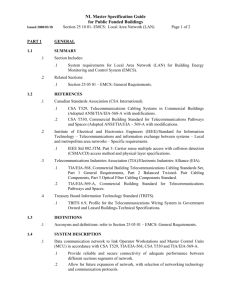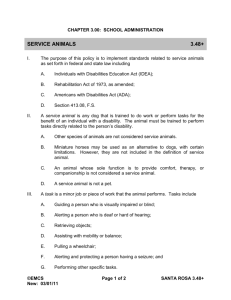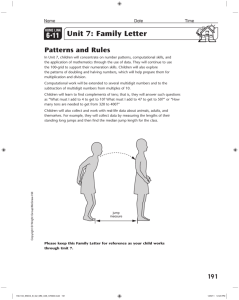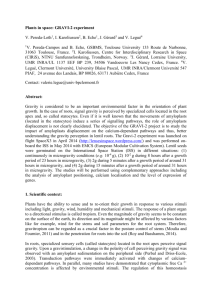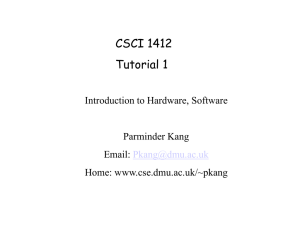ieu IL@ Pacific Bell 2600 Camino Ramon
advertisement
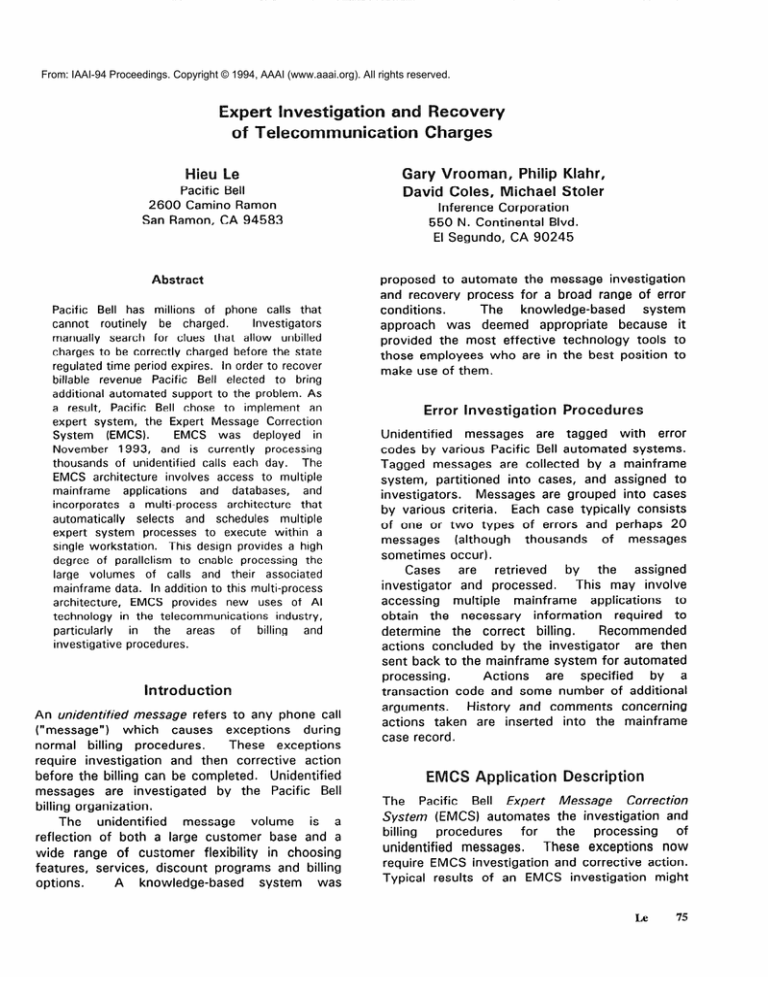
From: IAAI-94 Proceedings. Copyright © 1994, AAAI (www.aaai.org). All rights reserved. ieu IL@ Philip Klahr, ichael Staler Pacific Bell 2600 Camino Ramon San Ramon, CA 94583 Pacific Bell cannot has millions routinely manually be search charges time for billable revenue a Pacific result, system, System thousands EMCS of a large calls of and and parallelism mainframe architecture, technology particularly investigative data. in and provides databases, and that multiple processing their to this new telecommunications the The multiple schedules In addition in the day. to architecture enable calls EMCS an processing each areas of the associated multi-process uses of Al industry, billing proposed to automate the message investigation and recovery process for a broad range of error conditions. The knowledge-based system approach was deemed appropriate because it provided the most effective technology tools to those employees who are in the best position to make use of them. As to execute within a design provides a high to of bring implement access multi-process selects to problem. currently involves system processes workstation. This volumes to state to recover Message Correction was deployed in is applications automatically degree and unidentified incorporates expert single chose that unbilled the elected to the Expert EMCS architecture mainframe Bell Bell 1993, allow before In order support (EMCS). November that expires. the calls Investigators charged Pacific automated expert clues period additional phone charged. to be correctly regulated of Inference Corporation 550 N. Continental Blvd. El Segundo, CA 90245 and procedures. introduction An unidentified message refers to any phone call (“message”) which causes exceptions during These exceptions normal billing procedures. require investigation and then corrective action before the billing can be completed. Unidentified messages are investigated by the Pacific Bell billing organization. The unidentified message volume is a reflection of both a large customer base and a wide range of customer flexibility in choosing features, services, discount programs and billing A knowledge-based system was options. rror investigation Procedures Unidentified messages are tagged with error codes by various Pacific Bell automated systems. Tagged messages are collected by a mainframe system, partitioned into cases, and assigned to Messages are grouped into cases investigators. Each case typically consists by various criteria. of one or two types of errors and perhaps 20 messages (although thousands of messages sometimes occur). Cases are retrieved by the assigned This may involve investigator and processed. mainframe applications to accessing multiple obtain the necessary information required to Recommended determine the correct billing. are then actions concluded by the investigator sent back to the mainframe system for automated Actions are specified by a processing. transaction code and some number of additional arguments. History and comments concerning actions taken are inserted into the mainframe case record. The Pacific Bell Expert Message Correction (EMCS) automates the investigation and processing of the billing procedures for These exceptions now unidentified messages. require EMCS investigation and corrective action. Typical results of an EMCS investigation might System include billing the message as is, correcting a mistaken account number, holding a message until further information is available, or collecting all relevant data for the call from several different mainframe information systems and diverting the case for manual follow-up. Error Message Processing The principal requirement for the EMCS system was the automation of unidentified message The necessary set of investigation procedures. investigative procedures depends on the error codes found on the case. For the EMCS expert system, one of three categories of actions is possible: e Initiate a transaction to charge messages. Abeyance holds 0 Put the case in abeyance. Case a case for some number of days. processing is resumed following abeyance. 0 Divert the case to an investigator for manual investigation, for cases where manual handling is required. Once case processing is complete, individual messages are directed to one of several target applications for completion. High-Level Architecture The overall throughput of the EMCS application can be affected by several conditions, such as the time required to obtain data from the various mainframe applications. In an attempt to model the system throughput requirements, total daily processing time estimates were performed on volumes of cases and messages. Actual case and message volumes were sampled for a typical Error single day and for a complete month. messages were summarized according to external host access dictated by the error procedures defined during the requirements analysis phase. Some important results were evident from the Two resulting processing time analysis. components of mainframe access time were the mainframe application program modeled: response time (the average wait time while the mainframe was servicing other users plus the time necessary to process the data request) and the transmission delays in sending data over It was transmission lines of various speeds. discovered that both factors had a substantial The impact on overall throughput of cases. 76 UAI-94 conclusion from this analysis was that a single expert system image could not possibly handle the necessary workload because data could not be retrieved from the mainframe quickly enough. These observations resulted in a multi-process architecture, where multiple UNIX child expert system processes are maintained and supervised 1). Child (Figure by a parent EMCS process run concurrently on processes are the workstation, each with its own dedicated set of sessions to the communications necessary mainframe hosts. In the initially deployed system, five to seven of these child processes are run simultaneously on each workstation. Inference Corporation’s ART-IM for Unix was utilized as the programming language for EMCS because it representational provided the necessary capability, speed (data-driven architecture and compiled rules), and flexibility to implement this architecture. EMCS provides three primary modes of operation: e A test operation mode allows users to step through case investigation steps, providing a running description of information extracted from case messages or external database systems. Test mode does not send any update transactions back to the mainframe application. 0 An operation interactive mode provides display and interaction characteristics identical the test mode, except that update to transactions are enabled. Following user confirmation of proposed actions, transactions are submitted to the mainframe. batch l A mode of operation provides continuous case processing. EMCS maintains a cumulative statistical summary of cases Batch mode is processed for the session. used to service most of the case load. The batch subsystem is designed to allow multiple to be running EMCS batch processes concurrently (limited by the number of host ports attached to the workstation). The test and interactive subsystems of EMCS are designed as a single UNIX expert system process, while the batch subsystem is a multiprocess architecture designed in a parent/child configuration. The parent process has a graphical Motif-based user interface. This parent process uses the UNIX fork/exec system calls to spawn a HP 9000 Child EMCS Process Send-mainframe-transactions Le 77 user-specified number of batch child processes. independently processes Each child process cases, using a local case ID file and record locking to determine the case ID of the next case to process. Each child process writes out to a file a This file is updated set of summary statistics. after each case is fully processed. The parent process monitors the progress of its children, and allows an on-line user to view a The parent process summary of that progress. Tool kit utilizes XWindows X the XtAppAddTimeOut facility to automatically collect At the statistics at designated time periods. designated intervals, the timer expires and the parent process collect summary statistics by reading the output files generated by each child This information is summed and process. displayed in a Motif window. Once the batch system has been invoked, the system runs unattended, with summary information presented in a window on the screen. Statistics can also be updated via a menu choice when the user needs This menu choice causes an updated summary. the EMCS parent process to immediately total the statistics from all of its children and display this summary information in the window. When a particular day’s workload exceed both the primary mainframe EMCS’ capacity, application and EMCS are designed so that any unprocessed cases will automatically be rolled Each batch over into the next day’s work. process also automatically checks the time of day after processing each case. Just before the designated end of the business day, when the host systems are taken down for the day, each batch process stops case processing and logs off from the various host systems. Users can define the hours of operation for EMCS processing by setting the AUTOSTART and AUTOTERMINATE times in a dialog box available from the options menu. Once these times have been set, EMCS operates in self-scheduling mode. Should any communication problem occur with one of the host systems during normal business hours, any batch EMCS processes requiring data from that host system will be They will unable to complete their processing. simply generate the appropriate error message and exit. Normally, the host system problem is quickly fixed by the appropriate Pacific Bell Therefore, every few system administrators. minutes (as the timer expires), the EMCS parent process checks on the status of its children. If any children have terminated and unprocessed 78 IAAI-94 the EMCS parent process cases are pending, automatically spawns a new set of replacement In this manner, once the child batch processes. batch subsystem of EMCS has been invoked, it - EMCS processes are can run unattended If some abnormal automatically spawned daily. event occurs such as the workstation crashing, simply re-booting the workstation (if necessary) and logging back into the EMCS account will restore normal EMCS processing. The EMCS user interface was built in Inference Corporation’s Motif Integration Library (MIL). MIL is itself implemented in ART-IM and C using an object oriented methodology built on top of XWindows and provides an OSF Motif-based The basic EMCS user graphical user interface. interface design relies on the Motif Integration Library for access to Motif primitives, and relies on the ART-IM schema system to build higherlevel objects from those primitives. EMCS Reasoning Kernel The EMCS reasoning kernel can be invoked by the user directly from the application user interface (interactive or test mode) or invoked automatically at the start of a new business day (batch mode). The flow of control in the reasoning kernel is managed by a set of ruleset data structures. Each ruleset contains a set of rules which implement the detailed processing logic for each reasoning kernel particular stage of the processing. Just before it invokes the reasoning kernel, the calling c’ program asserts the ART-IM fact (li7itialile-EMCS). The presence of this fact causes certain initialization rules to fire in the li7itia//ie-EMCS ruleset. Once initialization is complete, the reasoning kernel repeatedly calls the get-case-summary function to retrieve the next case to process. Next, the reasoning kernel calls get-messagedetails to get the necessary data for each Then, depending on the message on the case. error code and other factors, other functions are called to collect data from the various mainframe systems. When there are no further cases to process, the reasoning kernel returns control to the calling C program. Representation of Declarative Knowledge EMCS data structures have been defined so that the application directly models, in a natural way, the underlying data and the key relationships To the investigator, for among the data items. example, it seems natural to view the data on each bill as a database record. Using an expert system approach, this maps into a bill object with an associated set of properties. In this approach, most of the main panel types for each host application map directly into objects. In ART-IM terminology, these panels map into schema definitions. A schema is a data structure into an which aggregates object properties For each associated set of slots and values. a message-detai/ schema is unbilled message, asserted at runtime. When EMCS decides upon appropriate corrective action for a particular message or set of messages in a case, an instance of the transaction-record class is generated which contains the details of the necessary corrective action. At the completion of case processing, a series of mainframe transactions are submitted, one for each transaction-record schema. Schemas are similarly constructed and dynamically asserted to hold the data returned by each of the different types of mainframe access functions. by the process-messages ruleset, transaction is created and sent. 5. cleanup-case ruleset contains a set of rules which perform cleanup actions at the end of processing an individual case. These cleanup actions re-initialize EMCS processing the next case. In EMCS, collections of rules that implement a task are organized into rulesets (Figure 1). Each major stage in EMCS processing is defined as a ruleset: 1 . initialize- EMCS miscellaneous first invoked. ruleset initializations when for Processing Logic The process-messages ruleset contains the rules which perform the critical decision-making tasks. These rules 0 decide which accessed e examine transaction e analyze situation mainframe the the fields information how to correct systems need to be host from to understand the the problem. An initial set of mainframe data is always In the retrieved when processing a new case. process-messages ruleset, a set of analysis rules fire which pattern-match against the initially Collectively, these retrieved mainframe data. performs rules decide systems must be accessed in order to process the Due to the volume of cases EMCS case. a large amount of mainframe data processes, These accesses are must be accessed daily. is ruleset retrieves a detail records, and performs problem. to tasks prepare EMCS 2. categorize-new-problem new case and message certain and 6. cleanup-EMCS ruleset contains rules which perform final cleanup, host logoff, and other termination actions at the completion of case processing for that day’s workload. e decide Rulesets a mainframe categorize the 3. process-messages ruleset contains rules action for which deduce the corrective particular messages in the case. The rules in this ruleset pattern match against messagedetail schemas and produce intermediate update generate or results, or they transaction-record schemas. Each of these schemas represent a particular corrective action to take and a list of the messages for which this corrective action is appropriate. 4. send-transactions ruleset is invoked after the messages of a case have been processed. For each transaction-record schema created which of the several other mainframe computationally expensive and without proper care could have degraded mainframe response times and other critical applications requiring mainframe access. Therefore, EMCS rules are structured so that, for each stage of processing, only mainframe data critical to the decision at Furthermore, the analysis rules hand is retrieved. decide which of the available data access methods to invoke in order to retrieve the required fields at minimal costs. The analysis rules express their decisions by asserting a set of ART-IM facts. As these rules assert facts specific to data needs, a set of datagathering rules are invoked. These rules perform the necessary book-keeping to ensure that mainframe data is never retrieved more than once. IA? 79 A set of ART-IM schemas have been defined which represent the various classes of mainframe system data. Each data retrieval, if successful, causes a schema to be created which is an instance of the appropriate mainframe system data class. As mainframe data becomes available in this form, decision-making rules become eligible to fire. These rules tend to be rather complex, typically with many pattern matches against the slots of different instances of mainframe system data schema. Frequently these decision-making rules invoke one or more sets of procedural calls which perform specific additional tests on the accessed data. If the data meets all of the conditions specified in the pattern-matching constraints, plus meets the conditions specified in the procedural logic, then EMCS has deduced the nature of the problem. EMCS then builds a transaction schema whose slots specify the particular details of the mainframe transaction that must be submitted to correct the problem. Mainframe System Access Several external database systems must be Information consulted during case processing. extracted from these databases governs decisions concerning billing of case messages. Connection with external systems is made EMCS at initialization, and is maintained for the duration of system processing. The EMCS application runs on an HP 9000 and requires data from several different applications which reside on IBM mainframe computers. For some of the above systems, mainframe connectivity is provided via UIA software from Apertus Technologies Incorporated. A total of 17 transactions were built which provide all the necessary data from these mainframe systems. The EMCS application can be running either on the same machine as UIA or on another networked workstation. The UIA does not currently provide interfaces to two of the mainframe applications, so EMCS utilizes a second communications pathway to access data from these systems. This second pathway is based on the high-level applications programming interface (HLLAPI), which was originally defined by IBM and is now a de facto industry standard for mainframe connectivity using 3270-type screens. Inference’s ART”SNA package was utilized to provide a higher-level 80 PAAI-94 interface for the EMCS application to access the various IBM hosts via HLLAPI calls. Application History The project encompassed a two-year timeframe from its initial conception at the end of 1991 to its deployment at the end of 1993. Approximate dates for the various phases of the project include: Dec91 -Jan92 Initial discussions based application on knowledge- Jan92-Mar92 Requirements analysis/high-level design/project planning Apr92-Ju192 Return on investment Aug92-Apr93 Detailed design & development May93-Sep93 Integration testing Oct93 Acceptance Nov93 Initial deployment analysis testing Of great benefit was a testbed of cases supplied by the user during the development on-going testing phase to provide an environment. Unit testing could be performed on This selected cases to verify code modules. representative testbed included cases encompassing the full range of cases that EMCS As such, it served as was required to process, the initial test suite for integration testing. In addition, other previously unseen cases were added to the test suite for further integration testing and acceptance testing. During the system integration and deployment phases, Pacific Bell software specialists joined the development team to become fully knowledgeable The original in the EMCS design and code. system developers continued to be involved in any bug fixes during the warranty period. EMCS Benefits There are many substantial business obtained from the EMCS system: benefits Improvements: EMCS e Productivity is designed to improve the productivity of the billing group through a more efficient application of investigation procedures. Much of the effort involved in message investigation is tedious and time consuming, suitable for an automated approach. 0 Consistent y and Completeness: Investigation procedures can be quite complex. EMCS provides a consistent application of policy to errors within its scope, providing detailed case information for future audit or manual investigation requirements. 8 Improved Responsiveness: Efficient EMCS processing of unidentified messages ultimately translates into improved responsiveness. * Additional Revenue Protection: The most significant benefit of the system is the avoidance of lost revenues due to message expiry. Based on the first three months of production, the additional revenue billed from prevented message expiry is projected to be more than a million dollars a year. Summary EMCS provides an innovative architecture which allows multiple expert system processes on each workstation to simultaneously investigate and recover telecommunications charges. The processes are spawned and monitored by a parent expert system process. This high degree of parallelism was necessary to handle the overall processing workload, given the inherent speed limitations of the mainframe connections. EMCS incorporates a robust architecture that allowed the system to automatically schedule its own operations and provide automatic recovery from common mainframe connectivity problems. In addition to this multi-process architecture, EMCS provides new uses of Al technology in the telecommunications industry, particularly in the areas of billing and investigative procedures. Rule-based processing was used to capture the expertise of human investigators. A process that had been done manually has been automated. Acknowledgments EMCS was a team effort involving many groups and individuals. Pacific Bell’s Strategic Information Systems (SIS) provided overall project management and technical monitoring. SIS head Eric Firdman helped launch the project; Rebecca Barfknecht supervised the development and integration process; Craig Cottrell provided ongoing project management; and Hieu Le was the technical monitor. From CBS, Paula Bentley headed the user community; Judy Rogers and Cathy Flores headed the northern and southern regions, respectively, and Marilee Yamarone, Delpha Stutznegger and Susan Jenkins provided the expertise on investigative procedures. Other important team members included Joseph Tung from UNIX system software support and Terry user software Rosfeld for application development. From Inference, Dave Coles provided the upfront requirements analysis and project initiation, Gary Vrooman and Mike Stoler were the principal developers with support from Sugandh Mehta, and Phil Klahr provided EMCS Apertus, who provided the project management. mainframe application transactions, was represented by Elizabeth Converse-Wilson, Shawn Hunter, Craig Cameron, Dan Riesland, and Dave Fisher.


